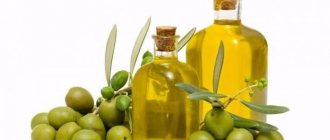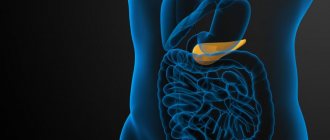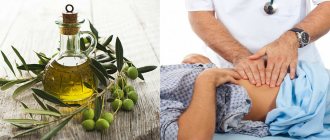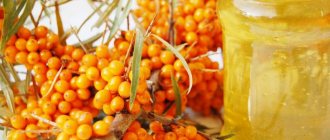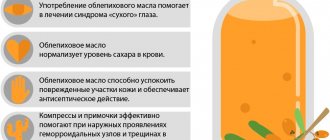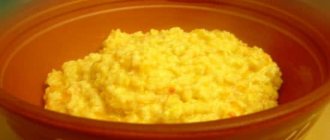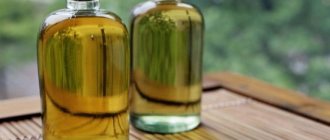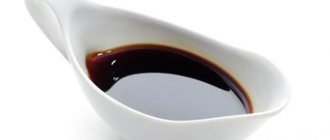Composition and beneficial properties
Oil of vegetable or animal origin is a fatty product that creates additional stress on the pancreas. During an exacerbation of the disease, their use is prohibited, but during the period of remission it is recommended to introduce a small amount into the diet. The benefits of consuming these products are explained by their beneficial properties:
- depending on the origin, the compositions of the oils differ, but each of them is a source of a large amount of vitamins;
- antioxidants help control oxidative processes in the body;
- fatty acids contained in oils are involved in various vital processes;
- high calorie content helps the body replenish energy losses;
- A small amount of oil makes food easier to digest.
Refined oil is not suitable for use for medicinal and prophylactic purposes. All beneficial substances and properties are fully preserved only in the product obtained by cold pressing. Proper consumption helps relieve inflammation, normalize digestion, reduce cholesterol levels, and strengthen the body.
For pancreatitis, it is recommended to use vegetable oil as a salad dressing or as an additive to already prepared dishes and not expose it to heat. Particular attention should be paid to storage conditions and preference should be given only to fresh products.
Vegetable
To maintain life processes, humans need fatty acids. Their source is unrefined vegetable oils: sunflower, olive, sesame, pumpkin, sea buckthorn, flaxseed.
Oils from black cumin seeds and pine nuts have pronounced choleretic properties and can aggravate inflammatory processes in the pancreas. They should be used with great caution and only in the absence of symptoms. If desired, you can add flax or sesame seeds or pumpkin seeds to your dishes.
Creamy
Butter is an animal product. It contains calcium, selenium, potassium, phosphorus, vitamins E, A, D, saturated fatty acids, such as oleic acid, which plays an important role in normalizing pancreatic function. Thanks to this, the product is easily digestible, promotes tissue regeneration, and regulates metabolic processes in the body. When buying oil, you need to pay attention to its fat content.
It is better to give preference to a product with a high fat content (from 80%), which contains the least amount of stabilizers, emulsifiers, etc. that are harmful to the pancreas.
Is it possible to eat walnuts and seeds if you have pancreatitis?
Walnuts and seeds contain a large amount of proteins and fats; they can easily replace meat or fish in composition. During the period of exacerbation of chronic pancreatitis, the use of these products is not recommended. And during the period of good health, that is, stable remission, the consumption of walnuts is allowed, but in small quantities (3 - 5 kernels per day). The seeds should not be consumed fried or in the form of kozinaki. You can use a small amount of raw sunflower seeds or in the form of homemade halva. Almonds, pistachios and peanuts are allowed to be consumed only during the period of no complaints, when there are no manifestations of pancreatitis. You need to start with 1 – 2 nuts, gradually increasing their number. Nuts can be added to cooked dishes (porridge, salads, casseroles).
Features of using oil for pancreatitis
The ability to introduce vegetable or butter into the diet directly depends on the patient’s condition and the form of pancreatitis.
In acute form
Consumption of vegetable oil in the first days can aggravate the patient’s condition, so it is added to food only after 2-3 weeks, if there is a positive trend and the digestive system copes well with carbohydrate and protein foods. It can be added to prepared purees, porridge or salad. At first, the daily norm should not exceed 5 g, and in case of stable improvement, it can be increased to 15 g.
Butter has a high percentage of fat content and can trigger a relapse. Its use is permitted no earlier than 15-20 days after the attack, in the form of an additive (up to 5 g) to purees and cereals.
In the chronic stage
During the period of remission, the use of various vegetable oils without heat treatment is allowed. In this case, it is necessary to strictly follow the recommended dosages to avoid overloading the pancreas. In small quantities, the product will have anti-inflammatory and antiseptic effects, improve appetite, and stimulate the gastrointestinal tract.
Refined oil is not suitable for use for medicinal and prophylactic purposes. All beneficial substances and properties are fully preserved only in the product obtained by cold pressing. Its proper use helps relieve inflammation, normalize digestion, lower cholesterol levels, and strengthen the body.
In the absence of symptoms of pathology of the pancreas, it is allowed to increase the daily intake of butter to 20 g, dividing it into several doses. It is best to add the product to warm dishes - milk porridges, soups, purees, or season boiled or steamed vegetables with it. When warm, it is absorbed much easier.
During exacerbation of the disease
In case of an acute attack of pancreatitis, vegetable oil and butter should be completely excluded from the diet. Avoidance of these products should be maintained until there is a lasting improvement in the patient's condition.
Cholecystopancreatitis
For cholecystitis and pancreatitis, it is recommended to use unrefined vegetable and fresh butter as a dressing for salads, ready-made cereals, soups, and purees.
It is undesirable to subject them to heating, during which the beneficial properties of the products are reduced. Their amount in the daily diet should not exceed 20 g. Before choosing the type of product, you should consult with your doctor.
Butter during remission of chronic pancreatitis
If you feel well, there is no nausea, abdominal pain and steatorrhea, the daily portion of butter can be increased to 20 g in 2-3 doses. For better absorption and preservation of more vitamins, it is added to warm food immediately before meals. Butter is allowed to season milk and crumbly porridges, vegetable and fruit purees. It is not recommended to use butter for making sandwiches - cold fat is more difficult to digest.
Tips for selection and use
First of all, do not try to reduce the harm from fats by buying a product with low fat content: real butter simply cannot be low-fat and must contain at least 70% fat (peasant - 72.5%), and even better - more than 80% (amateur - 80% and traditional – 82.5%). According to modern Russian standards, products with a fat content of less than 70% (tea and sandwich butter) can be called oil, but GOST initially allows the use of more additives (salts, stabilizers, preservatives, emulsifiers, flavorings, dyes). That is, the lower the fat content of the oil, the higher the content of additives in it, which will cause much more harm to the pancreas than the fat itself.
What else to pay attention to:
- Labeling: The product name must contain the word “oil”. Everything else is a combination of butter with vegetable fat (spread) or margarine.
- Expiration date and storage conditions (must be stored only in the refrigerator).
- Packaging (the best option is foil packaging, which retains more valuable substances and prevents oxidation).
To avoid poisoning or infection, purchase only factory-made butter made from pasteurized cream. Before each use, cut off the top oxidized dark yellow layer.
Rules for eating oil for pancreatitis
Fats are a source of many essential acids, without which the normal functioning of cells in the human body is impossible. The source of fats is vegetable and animal oils. But in the case when a person is sick with pancreatitis, a product so necessary for the body can cause an exacerbation of the inflammatory process in the pancreas.
Any fats enhance the production of pancreatic juice, which contains enzymes that are necessary for digesting food. But with pancreatitis, enzymes digest not only food, but also the pancreas itself, which causes an exacerbation of the disease. However, fats must be included in the human diet. In this case, only strict adherence to the rules for eating oils will help maintain a balance between maintaining gentle conditions for the diseased organ and consuming the required amount of fat for the body.
Composition and beneficial properties
The most valuable substances contained in vegetable oils are fatty acids.
They are divided into 2 categories - saturated and unsaturated. The benefits of the latter for the human body can hardly be overestimated. They are needed:
- to renew the membranes of body cells;
- to remove “bad” cholesterol;
- for building nerve fiber sheaths;
- to regulate metabolic processes.
These acids are not synthesized by the body, so they must be administered with food. Soybean, rapeseed and sunflower oils are rich in unsaturated acids.
Saturated fats are needed by the body in much smaller quantities. Over time, their excessive consumption can cause the formation of atherosclerotic plaques in blood vessels and lead to metabolic disorders. The highest amounts of saturated fat are found in coconut, palm and peanut oils.
Fats are the main source of vitamins A, D, E, K and at the same time a necessary condition for their absorption, since these vitamins are fat-soluble. Sterols present in fats are involved in the production of many hormones and also ensure the absorption of calcium.
In addition, vegetable fats contain:
- phospholipids;
- proteins;
- nitrogenous compounds;
- pigments;
- waxes;
- free amino acids;
- minerals.
Another beneficial property of vegetable fats is their choleretic effect. Regular consumption of olive, cedar, and black cumin oils promotes timely cleansing of the gallbladder, ducts, and dissolution of bile clots.
The use of oil for pancreatitis is not only acceptable, but also necessary. When used correctly and in dosage, some types of vegetable oils can have a powerful therapeutic effect:
- improve the functioning of the gastrointestinal tract;
- regulate the functioning of the gallbladder;
- restore pancreatic tissue.
DO YOU STILL THINK THAT IT IS HARD TO CURE YOUR GASTROINTESTINAL TRACT?
Judging by the fact that you are now reading these lines, victory in the fight against diseases of the gastrointestinal tract is not yet on your side.
Have you already thought about surgery? This is understandable, because all organs of the gastrointestinal tract are vital, and their proper functioning is the key to health and well-being. Frequent abdominal pain, heartburn, bloating, belching, nausea, bowel dysfunction. All these symptoms are familiar to you firsthand.
But perhaps it would be more correct to treat not the effect, but the cause? We recommend reading the story of Galina Savina, how she cured gastrointestinal problems. Read the article >>
Lamb and acute pancreatitis
Lamb fat is considered the main culprit for the fact that lamb is strictly prohibited during acute and current exacerbation of chronic pancreatitis. Despite the fact that there is less fat in this meat than in pork, it differs from the fats of other types of meat (beef, rabbit, etc.). So, lamb fat:
- is a leader in the amount of saturated fatty acids;
- turns out to be the most refractory;
- It is more difficult to digest and much worse to absorb.
Features of use
The use of vegetable fats for pancreatic pathology is allowed only during remission. They can be consumed both in pure form on an empty stomach and as dressings for dishes. In order not to provoke an exacerbation of pancreatitis when consuming oil on an empty stomach, the dosage must be observed: the product should be introduced into the diet slowly, starting with ½ tsp. and gradually bringing to 1 tbsp. l. The amount of oil used for cooking should also be increased gradually.
It is better to use refined oil for frying, and unrefined oil for dressings.
In acute form
In the acute form of pancreatitis, the patient must follow a strict diet: the first 2 days - complete fasting, then you can include in the diet foods that are gentle on the inflamed organ. Fats of both plant and animal origin increase the secretion of the pancreas, which is unacceptable during times of exacerbation of the disease. Therefore, the consumption of any fat-containing foods during the acute stage of pancreatitis is strictly prohibited.
In the chronic stage
In the chronic stage of pancreatitis, the use of both vegetable and butter is mandatory. During this period, the pancreas is able to cope with their processing, which means that the body will have the opportunity to replenish its reserves of necessary substances. The same period is favorable for taking oils with pronounced therapeutic properties, such as cedar or black cumin. The therapeutic effect will be maximum.
During exacerbation of the disease
In case of exacerbation of pancreatitis, the use of any fats is completely excluded. You can return fat-containing foods to the diet no earlier than a month after the end of the attack, provided that the symptoms of the disease have completely disappeared and the patient’s condition has stabilized.
Cholecystopancreatitis
Vegetable oils have a powerful choleretic effect. Their constant presence in the diet improves the flow of bile. However, cholecystitis in most cases is accompanied by the presence of gallstones. By stimulating the flow of bile, large stones can be set in motion, which poses a threat to life. In this case, urgent surgery will be required. Therefore, in case of cholecystopancreatitis, the consumption of vegetable fats should be under the strict supervision of a doctor.
Is it possible to use butter for pancreatitis?
Butter belongs to dairy cuisine with a high fat content, the use of which in case of pancreatitis will cause complications. Those affected by pancreatitis understand that the pancreas, when consuming a creamy product, will release a huge amount of enzymes into the stomach and duodenum, which is undesirable for this pathology.
True, a complete ban on butter should not be done either, since during a period of stable remission, the food additive will bring good benefits to the affected body.
Rules for using oil in the presence of pancreatitis
Before using the oil for the treatment of pancreatitis, you must study the rules of administration discussed in the list below:
- The disease is characterized by inflammation of the pancreas, so the amount and frequency of administration must be followed according to all treatment recommendations;
- The maximum dosage of oil is no more than 2 tablespoons per day;
- Consumption of oil during a period of stable remission, since during an exacerbation, additional complications may develop;
- Compliance with the shelf life of an opened bottle of oil (shelf life of some types of product is 1 month);
- Mandatory coordination of the chosen technique with the attending physician;
- Oils of vegetable origin can be used with other products and folk remedies, if there are no obvious contraindications for use;
- Taking the highest quality product, since the presence of artificial additives contributes to the aggravation of the symptoms of acute pancreatitis.
What are the benefits of butter?
The content of vitamins: A, D, E, makes this food necessary for high-quality hair growth and strengthening of the skin and nails. By participating in intercellular processes, damaged skin is restored (regeneration). The creamy food product helps in the human digestive tract.
The creamy fat product contains cholesterol, which is considered a big problem, but not many people know that cholesterol is very necessary for our body, as it is part of the cellular composition of membranes. Based on cholesterol, many hormones and different types of acids are created and exist. To make it clearer, a creamy product causes harm only when consumed in abundance and without control.
Butter fat also contains the amount of phosphorus, calcium, and phospholipids needed by the body, and this improves the functioning of the internal organs of a person and the body as a whole.
Pay special attention to buying it in stores and what to look for:
- best before date;
- fat content from 82.5%;
- color shade.
An oil product with a fat content of up to 82% is not healthy, since it contains a high content of stabilizers, emulsifiers, and refractory fat essences. These supplements cause devastating harm to the pancreas and the human body, and even more so during inflammatory processes in the pancreas.
Use for pancreatitis
The nutritional value of the creamy contents is indisputable; it is well absorbed in the body, does not overly burden the pancreas and the entire gastrointestinal tract, and supplies the body with useful minerals and vitamins. Having such a list of benefits, the product can still cause harm to the person who consumes it. So is it possible to consume butter if you have pancreatitis? This question plagues many people with this pathology.
Pancreatitis has two types of development:
- acute pancreatitis;
- chronic type of pancreatitis.
For each type of pathology of pancreatic disease, individual permission for use is required, so whether or not butter is allowed for pancreatitis depends on the stage of development of the disease and the general condition of the patient.
The doctor will tell you whether it is possible to eat butter during a pancreatic exacerbation or a chronic disease of the pancreas, but it all depends on the clinic of the patient’s illness. There are generally accepted rules for using this creamy product for different forms and types of pancreatitis.
For chronic pancreatitis
Is it possible to eat butter with chronic pancreatitis? At this stage of the development of the disease, the creamy product is necessary for the body damaged by pancreatitis.
Thanks to the abundance of vitamins and valuable minerals, consumption promotes and accelerates recovery and restoration of the body during the period of remission of pancreatitis. The main thing during the period of stable remission is not to overdo it or abuse the norms and doses of nutrition.
Rules for using butter in food:
- eat only if there are no pain symptoms in the gastrointestinal tract;
- do not use during periods of nausea;
- daily intake of no more than 30 g of creamy product per day;
- use it only warm in addition to cereals and salads;
- monitor the quality of the product consumed, without signs of mold and yellow oxides.
In the acute stage
During an attack of pancreatitis of the pancreas, for the first 72 hours, eating food is completely prohibited, with the exception of water and mineral waters without gas. In medicine, the procedure is called therapeutic fasting. Only after carrying out this type of treatment will the attack of pancreatitis be stopped and you will switch to a full dietary complex of food intake.
What should you not eat if you have chronic pancreatitis?
- Fatty meats (lamb, pork, duck). To digest such food, a large number of enzymes are required. And the inflamed pancreas works in a limited mode.
- Beef and chicken liver is not recommended, as it is an extractive substance that leads to increased production of digestive system enzymes and activates appetite.
- Fatty fish (mackerel, salmon, herring), especially fried fish, are strictly prohibited. You should also not eat canned fish.
- Vegetables with chronic pancreatitis should not be eaten raw. Among the prohibited vegetables are white cabbage, tomatoes, cucumbers, spinach, onions, radishes, and beans. When consumed in large quantities, they enhance fermentation processes in the intestines, which leads to bloating.
- Mushrooms in any form are not recommended, nor are mushroom broths.
- Scrambled or raw eggs. Raw yolk especially stimulates the production of bile, which is undesirable for patients with chronic pancreatitis.
- The consumption of millet and pearl barley is not recommended.
- Smoked meats, sausages.
- Pickled food, pickles, spices.
- Black tea or coffee, hot chocolate and cocoa.
What kind of oil can you eat?
The most useful product for pancreatic diseases is considered to be cold-pressed olive oil. With this method of obtaining it, many beneficial properties and microelements remain, and when eaten, they also have healing properties on the body of the affected person than after thermal treatment.
Composition of olive oil:
- Omega-9 – helps improve metabolism in the body;
- lipoic acid – is a strong antioxidant, prevents the occurrence of cancer cells and curbs the negative impact on a person with diabetes;
- stearic and palmitic acids – replenish the body’s energy and fat balance, but if the permissible consumption is exceeded, it greatly increases cholesterol in the body and blood vessels;
- Omega-3.
The product, having such beneficial substances, is recommended for various diseases, but strictly according to the prescribed dietary table.
It is difficult to determine which of the olive oils and butter products is more valuable for an organism damaged by pancreatitis, but they all have increased fat content and will provoke an increase in the secretion of pancreatic enzymes, which is unacceptable in case of the disease. Therefore, eating foods requires a careful approach to consumption and strict adherence to the rules.
Using oil for pancreatitis
Pancreatitis is an inflammatory process affecting the pancreas. Elimination of this pathology mainly consists of prescribing a special dietary regimen. Animal and vegetable fats play a very important role in such a diet, ensuring normal processes of the functionality of the whole organism at the cellular level. Butter contains very large amounts of healthy fats. Therefore, you need to know that not every oil can be eaten for pancreatitis of the pancreas, since it can not only act as a beneficial ingredient, but also cause serious damage to health. In this review, we will consider in more detail how and what oil can be used in food during the development of acute and chronic pancreatitis.
Use of coconut oil for pancreatitis
Coconut oil for pancreatitis is a useful product, as it has a unique composition and ensures rapid absorption, which means good absorption of the food consumed. Therefore, the product has a beneficial effect on the overall digestion process in the body.
The product has many useful properties:
- Reducing blood cholesterol;
- Slowing down the aging process of cells;
- Gaining elasticity of blood vessels, which significantly prevents the risk of heart attack and stroke;
- Improving blood circulation in the brain;
- Reduction of epilepsy attacks;
- Prevention of varicose veins;
- Regulation of the thyroid gland;
- Improved digestion;
- Prevention of the development of diseases of the gastrointestinal tract;
- Strengthening immune function;
- Normalization of liver and kidney function;
- Reducing the load on the liver;
- Dissolution of kidney stones;
- Rapid absorption of beneficial microelements in the body.
Coconut oil can be used in the treatment of pancreatitis only after consulting a doctor, since each organism is individual and with insufficient recovery, an exacerbation of the disease may occur.
Sunflower oil
Different varieties of sunflower oil have different components, which depend on the methods of growing sunflowers and the method of processing them. Any variety of this product contains:
- vitamin complex consisting of vitamins A, B, D and E;
- compounds of carbohydrates and proteins;
- lecithin and phytin;
- linolenic acid;
- oleic acid;
- tanning components;
- mineral compounds.
One of the most important components of sunflower oil is the substance phytin, which helps improve the intensity of hematopoiesis processes, the development of bone tissue in the body and the activity of the nervous system. Moreover, it intensively strengthens the body's protective properties and helps improve metabolic processes.
Despite such a wide range of positive properties of this product, it can be used in acute cases of pancreatitis, but only with extreme caution. It is recommended to introduce its use into the diet during the period of remission.
Use for acute pancreatitis
Sunflower oil is not recommended for use in acute pancreatitis, as it contains saturated enzyme compounds, which during an exacerbation of the disease can contribute to increasing the speed and intensity of destructive processes in the already inflamed pancreas.
But complete exclusion of this product is also not recommended, because the vegetable fats it contains are a necessary component involved in many vital processes in the human body.
Therefore, vegetable oil must be present in the diet. But its use is permitted from the moment when positive dynamics of treatment are observed and the general condition begins to normalize.
Use during remission of the disease
Vegetable oil for pancreatitis during the period of weakening or complete disappearance of its characteristic symptoms of manifestation can be used both for cooking and as a salad dressing.
If a person does not develop gallstone pathology and stool disorders, then sunflower seed oil should be introduced into the diet from a minimum dose, gradually increasing its portion size in the absence of negative reactions from the body.
It is important to remember that heat treatment of this ingredient contributes to the destruction of all beneficial substances contained in its composition, and the product ceases to be useful. Therefore, it is better to use unrefined oil to add to warm vegetable purees, porridge, or salads.
Is it possible to consume butter if you have pancreatitis?
During the development of pancreatitis, butter is well absorbed in the body and helps improve digestion. At the same time, the product contains a large amount of cholesterol, which can negatively affect the recovery of the body.
The oil has a considerable list of beneficial properties:
- The content of oleic acid helps improve the digestion process and rapid absorption of food;
- The presence of antioxidants prevents the development of oxidation processes, which has a beneficial effect on the recovery of the body;
- Regeneration of cell walls and processes in the body.
In order to get the proper effect from butter in the treatment of pancreatitis, you must follow the recommendations given in the list below:
- Use is possible only in the absence of nausea and abdominal pain in a sick patient;
- A one-time amount of oil should not exceed 10 grams, and the daily dosage should not exceed 25 grams;
- Oil should only be consumed in a melted state. It is best to add the product to porridge or vegetable soups;
- During use, it is necessary to cut off the oxidized pieces of butter that have turned yellow in color. The product should be stored in a closed container in the refrigerator.
When directly choosing oil, you should pay attention to the following tips:
- Purchasing butter with a fat content of at least 72%, since this product does not contain additional ingredients of synthetic origin;
- Natural oil is stored in foil, so you need to buy the product in this packaging;
- Control of terms and storage conditions of the purchased product;
- The natural butter content is based on the presence of pasteurized cream. If the product contains other impurities, then it is unsuitable for use for pancreatitis.
Using butter
If you have pancreatitis, you need to eat correctly, following a balanced regimen of consuming beneficial nutrients, vitamins and mineral compounds. Therefore, butter for pancreatitis should also be included in the diet of a person suffering from this disease. After all, it contains vitamin complexes of the following groups: A, D and E, which actively take part in the processes of structure of hair and nail plates, as well as in the regeneration of tissues and cells. That is why eating butter is very useful for the pancreas, especially during the development of the inflammatory process in it, especially since this product also contains calcium, phosphorus compounds and beneficial phospholipids.
This food product is well digestible for the digestive tract and does not overload either the pancreas or the stomach. But, despite the presence of such a wide range of positive qualities, this ingredient also has a negative side - it is cholesterol, the use of which in moderate portions can help slow down metabolic processes and also have a negative impact on the performance of the digestive tract system.
The consumption of butter should be strictly limited to certain portion sizes.
To prevent negative consequences from consuming this delicacy, you must follow the following rules for its use:
- Eat oil only when you feel excellent, when you are not bothered by pain in the gastrointestinal tract or a feeling of nausea.
- Follow the daily intake of this ingredient, which should not be more than 25 grams.
- There is oil for pancreatitis, it is recommended warm, as an addition to freshly prepared puree or porridge.
- It is necessary to consume only fresh product; if small areas of oxidation appear, they must be removed with a knife.
In the chronic form of the inflammatory process of the pancreas
During the period of remission of pancreatitis, butter must be included in the diet. Due to the wide range of beneficial qualities of this product, its use during the inflammatory process of a parenchymal organ will contribute to the fastest process of restoring its functionality, but the main thing is not to overdo it with dosages. An important condition is compliance with the recommended daily dose and the rules for its use.
During the period of exacerbation
If the inflammatory pathology of a parenchymal organ worsens, especially during the first day, complete fasting is recommended, so the use of butter is completely excluded.
This product can appear in the diet only after an improvement in general well-being and with positive dynamics of treatment.
Butter is a source of vitamins
A balanced diet along with drug therapy is an important point of treatment. The diet should include oils, including butter, containing vitamins A, D, E. They affect the condition of the skin, hair, nails and take part in the construction of cell membranes.
In addition to vitamins, the product contains phospholipids, phosphorus and calcium, as well as cholesterol, which in large quantities has a negative effect on metabolism and the condition of blood vessels.
NATALIA LUKINA: “How did I manage to defeat pancreatitis at home in 1 week, spending 30 minutes a day?!” Read more >>
Pancreatitis and olive oil
Olive oil for pancreatitis should also be included in the diet, as it can have the following positive effects:
- improve digestive processes in the gastrointestinal tract;
- prevent the appearance and development of atherosclerotic plaques;
- saturate the human body with a useful set of vitamin and mineral components;
- due to the content of oleic acid, accelerate the processes of assimilation of fatty compounds;
- improve the functioning of the affected organ;
- alleviate the symptoms of pancreatic lesions of the pancreas.
Which oil for pancreatitis is useful to use in the diet?
The normal functioning of the pancreas is ensured by adherence to dietary nutrition and oil products that have regenerative properties. Produced from animal components, has a detrimental effect on the course of the disease.
When using various oil products correctly, it is recommended not to completely exclude them from the diet. Based on the fact of necessity, a statement about a positive influence follows.
Many patients ask the question, is it possible to eat food with added oil? Doctors advise moderate use with proper steaming.
Butter for pancreatitis
Contains a high fat content that forms cholesterol. This, in turn, reduces the production of enzymes, causing obesity. The rate of processing of components decreases by 3 times, and fat deposits are created.
High calorie content makes absorption difficult. The vitamin content helps control metabolism. Regenerates and increases the speed of tissue healing. Microelements (phosphorus, potassium, calcium, iron, sodium, phospholipids) are necessary for humans.
Attention! The acute stage prohibits the consumption of butter.
The chronic form of the disease does not accept sandwiches. The best option is to add it to food.
The video will tell you about the dangers of sandwiches:
- There is no pain, vomiting, nausea;
- Daily dose 10–33 g;
- Eat fresh, not expired food;
- It is recommended to heat dishes for better digestibility.
Butter contains only components of animal origin without the addition of vegetable fats. Manufacturers often include palm supplements, which cause aggravation of the disease and an increase in the formation of cholesterol deposits.
The fat content contained in the original oil products is 75–85% without dyes, stabilizers, flavors, or preservatives.
Vegetable oil for pancreatitis
Excessive consumption of vegetable oil for pancreatitis affects the stones, moving them along the duct. There is a risk of blockage of the channel that removes enzymes. Therefore, you should carefully use the squeeze for cholelithiasis.
Sunflower contains 11 times the amount of vitamin E. The oil supports the immune system by lowering cholesterol levels. Rich in unsaturated fatty acids (oleic and linoleic, Omega 6) similar in similarity to the oil product made from olives.
Attention! The allowed daily intake is no more than 25–30 grams. Introduction to the diet begins with 1 tablespoon.
The influence of light negatively affects the quality of products. The addition of preservatives has an effect on the pancreas, creating an exacerbation of the disease.
The most useful is considered to be the first cold press, due to which unsaturated fats are released in their pure form. Contains vitamins A, B, D, choline necessary for gland disease.
Despite the disease, the gland needs fats. Moderate addition to food has a beneficial effect on the condition as a whole.
Use in remission
- Linen;
- Cedar;
- Sea buckthorn;
- Caraway (contains a high content of essential components, allowed after consultation with a doctor);
- Coconut;
- Caraway;
- Mustard.
Each inclusion in food begins with a minimum amount, carefully observing the body’s reaction. The occurrence of pain indicates cessation of use.
Cumin oil for pancreatitis
Cumin oil is used as a dietary supplement rich in B vitamins (B1 – B12), copper, calcium, iron, zinc, phosphorus, linoleic and oleic acid.
Sustained remission allows for preventive treatment of the pancreas. Essential substances have an effect on the fungal and microbial environment. Thymoquinone lowers blood sugar levels and restores appetite. Acts at the level of diuretics and choleretic agents.
Attention! Contraindicated in case of cholelithiasis. The course of the acute stage.
The daily consumption rate is 1 teaspoon per day. The nutritional supplement is suitable for patients suffering from diabetes. The development of parenchyma tissue pathologies and high acidity of gastric juice causes an exacerbation of the disease.
It is impossible to unequivocally answer the question which oil is better? Each type of product is useful in its content. Negatively reflected in the acute form. In this case of illness, use is prohibited.
Butter belongs to dairy cuisine with a high fat content, the use of which in case of pancreatitis will cause complications. Those affected by pancreatitis understand that the pancreas, when consuming a creamy product, will release a huge amount of enzymes into the stomach and duodenum, which is undesirable for this pathology.
True, a complete ban on butter should not be done either, since during a period of stable remission, the food additive will bring good benefits to the affected body.
Olive oil in the diet and the development of pathologies
An overloaded organ can cause pathological phenomena. The body needs olive oil for pancreatitis due to its positive effects. But a high fat content indicates calorie content and the possibility of pathological exacerbation.
Positive effective quality
- Normalizes the working functions of digestion;
- Blocks the development of cholesterol;
- An indispensable means of replenishing microelements and a complex of vitamins;
- Oleic acid helps digest unsaturated fats;
- The pancreas improves performance;
- Symptoms of the disease do not create much discomfort due to the content of Omega – 3, Omega – 6, Omega – 9;
- Vascular atherosclerosis develops at the slowest rate.
Important! Useful qualities are preserved in fresh oil that is not subject to thermal influence.
After the pain symptom has been relieved, it is allowed to be included in the diet after 35–40 days of persistent, stable remission have elapsed.
Pumpkin oil for pancreatitis
Pumpkin oil contains a whole complex of vitamins and microelements. It is especially indispensable for patients suffering from a lack of vitamin B. Pumpkin pulp and seeds are a source of necessary materials and components from B1 to B12 for the recovery process.
Remission allows you to take 1–2 teaspoons on an empty stomach in order to prevent the disease. The method helps to normalize metabolism, remove toxic substances and waste from the body, and break up gallstones.
In the acute form, the oil provokes the process of tissue death and increased production of digestive acid.
Is it possible to drink sea buckthorn oil for pancreatitis?
When considering the question of whether it is possible to drink sea buckthorn oil for pancreatitis, it is necessary to clearly understand that the use of the product is possible only with long-term remission. This product is of plant origin, therefore it has a beneficial effect on the body’s recovery process.
Sea buckthorn oil has pronounced beneficial properties in the form of antioxidant and anti-inflammatory effects. The product contains a large number of useful substances: vitamins B, C, K, E, carotenoids, calcium, magnesium, iron, silicon, nickel, manganese.
Internal use of sea buckthorn oil is recommended to prevent the disease. Prepare a medicinal solution in the proportion of 0.5 teaspoon of the product and 250 ml of warm boiled water and use it twice a day before meals.
The dosage of sea buckthorn oil for the direct treatment of pancreatitis is prescribed individually by the attending physician. The maximum amount for one-time use is no more than 1 teaspoon.
